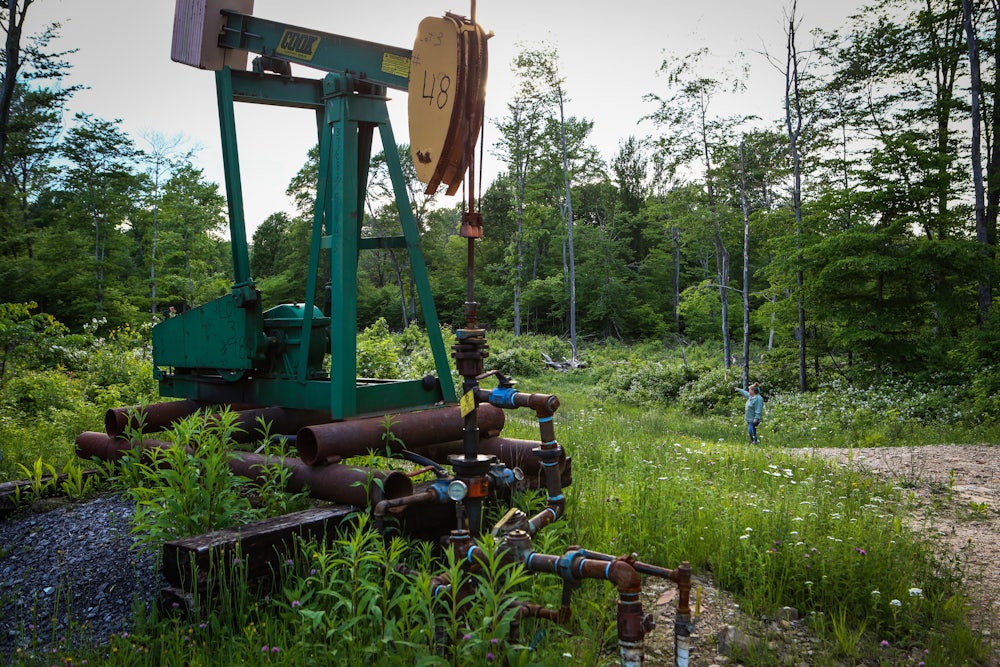Last August, the U.S. Department of the Interior announced $76 million in federal funding to support Pennsylvania in properly decommissioning gas and oil drill sites the industry has abandoned. More than 30,000 of these so-called orphaned wells dot the landscape of Pennsylvania, where a legacy of oil and gas exploration goes back 150 years. Unless properly managed, they can continue emitting methane and poisoning groundwater.
The funding, part of a $4.7 billion federal effort, aims to “help create good-paying union jobs, catalyze economic growth and revitalization, and reduce environmental and public health impacts from harmful methane leaks.” The idea is simple enough: Clean up the mess left behind by the fossil fuel industry while employing the very same workers it no longer relies upon.
The program could be a progressive fantasy, advancing both organized labor and climate goals in lockstep. There’s just one big problem. The skills needed to plug wells, a highly specialized job on the oil patch, can’t be found in union halls. While the federal well-plugging program has prevailing wage requirements for workers and a preference for union membership when awarding contracts, oilfield service companies—which is where people pick up these skills—typically aren’t unionized.
The Keystone State isn’t the only one clamoring for a solution. Since 2022, hundreds of millions of dollars have already been pumped through states to address festering wells without getting anywhere near unions. “The federal government often puts the cart before the horse,” says Josh Sonnier, president of Ironworkers Local 623 in Baton Rouge, Louisiana. “They came up with a great idea, they put all that funding together, but they didn’t think it all the way through with the workforce.” One possible solution is being explored in California, where a small workforce-development program is training union members to plug wells. But duplicating that approach elsewhere and marshaling union power for orphan well remediation doesn’t come easily.
As the fossil fuel industry has transformed over the last decade—facing stiffer competition from renewables and improving extraction efficiency, which requires fewer workers—employee rolls have dwindled. The biggest losers have been industry workers in Appalachia and the Gulf Coast. The task of extracting natural gas and oil in Appalachia employs fewer than 30,000 workers, around half of the number required during the shale boom of the early 2010s. Louisiana’s oil industry is in the midst of a similar exodus, cutting 20,000 names, or 40 percent of the workforce, from employment rosters since 2014.
With a 150-year legacy in fossil fuel exploration, the nation is littered with remnants of bygone oil booms and busts. Recent environmental concerns and federal funding have led to more diligent recordkeeping, but experts suspect the true number of orphan wells exceeds official tallies. Records across states reveal more than 100,000 orphan wells, but the Interstate Oil and Gas Compact Commission estimates a total of around one million orphan wells.
Well remediation could stimulate struggling economies. Kentucky, Ohio, Pennsylvania, and West Virginia are likely to receive more than $1.3 billion combined through the orphan well program, which would translate to more than 2,400 jobs, according to a February report from the Ohio River Valley Institute, or ORVI, a think tank based in Appalachia. The report also found that workers’ paychecks could stimulate the local economy enough to create another 11,000 jobs. True Transition, an organization that advocates for an egalitarian energy transition to renewables, estimates that federal funds headed to the Gulf Coast would similarly create thousands of jobs.
But what kinds of jobs will they create? When the first batch of funds reached Louisiana two years ago, the state’s Department of Natural Resources awarded all $25 million to two subcontractors, Dynamic Group and Lemoine Disaster Recovery. Neither had any experience in well remediation—which remains unchanged, as both have simply subcontracted their work to other companies.
When Megan Milliken Biven, founder of True Transition, went out to speak with workers on sites who were contracted to plug the wells using the federal funding, she found not trained rigger pluggers but day laborers. “I’m not accusing anyone of being bad or doing a bad job. We can’t know,” she told me. Properly plugged wells don’t come by chance but by putting a system in place that guarantees them.
Biven thinks those workers are also losing out. “They weren’t salaried, they weren’t insured, anything like that,” she says. Even with prevailing wage requirements, rates in Louisiana are particularly low, with some oil patch work hovering around $10 per hour. “We don’t have good labor law,” says Biven. “And so we’re in a pickle.”
The True Transition report argues that “unions play a pivotal role in lifting wages and benefits for their members while also providing large benefits to communities and the workforce,” in the form of stronger safety norms and raising training standards. But bringing those benefits to federal well-plugging contracts would require either hiring from union shops (which currently don’t have well-plugging skills) or unionizing the existing oil-patch workforce. For a sense of what a starting plan might look like, labor advocates are looking to Bakersfield, California.
In 2022, the Golden State’s legislature greenlit a plan to use a $15 million grant from the California Workforce Development Board to establish a curriculum for would-be well pluggers from trade unions. The result was a partnership between a well-plugging operator called California Legacy Well Services in Bakersfield and a pair of trades unions, Operating Engineer Union Local 12 and the LIUNA Local 220.
Starting last year, the course began training classes of seven workers, all either already members of the unions or in the process of joining. With the money available, the program aims to train around 100 workers by the end of 2024 and hire them to plug a batch of well-plugging contracts.
As a result, as California turns to its own tranche of federal funding to plug wells, which amounts to more than $70 million, it can be sure workers are available for the job—and that they’ll be paid fairly.
Christine Baker, an environmental consultant who helped design the California program, hopes this approach will spread. “This is a model program, with all the steps that are required, so that it can be used and replicated in other states or other jurisdictions,” she says.
Earlier this year, Baker assisted a constellation of Appalachia-based labor unions and advocacy groups, including ORVI, in applying for an Environmental Protection Agency Community Change Grant for a project very similar to the one in California, to establish a workforce development program in the Southeast.
“There’s going to be so much that’s going to be happening over the next 10 to 15 years,” says Chad Mills, state director of Kentucky’s Building and Construction Trades Council, which represents more than 18,000 workers and is part of the group applying for the EPA grant with ORVI. “We would like to see organized labor play a part in it,” he says, adding, “I think the [Biden] administration would as well.” Mills also tells me that the unions have engaged in tentative talks in the last year with Governor Andy Beshear.
Pennsylvania’s executive branch is flexing its muscles too. In August, the administration of Governor Josh Shapiro announced a partnership with the United Mine Workers of America’s Career Center to offer courses that train workers in well plugging. Though the UMWACC is a spin-off from the UMWA, courses are available to non–union members.
The Kentucky BCTC and several other labor organizations will have a central role if the EPA approves the grant application for a workforce training program in Appalachia. The bigger challenge, in Appalachia or elsewhere, comes with getting a contractor to buy in, becoming an incubator and employer of union members who train to plug wells. While the EPA Community Change Grant has strict rules preventing any such deal from being made without a bidding process, there are concerns around finding a willing well-plugging contractor when the industry has virtually no union penetration.
If all goes according to plan, the community change grant would offer the funding necessary for unions and labor advocates to partner with a reputable well plugger to train workers. As in California, that company would use federally funded plugging contracts to offer workers on-the-job training. The wells would be plugged using union labor, and those workers would walk off the job site ready to plug more wells and beef up the available workforce. Even if other plugging companies bidding for federal plugging jobs would prefer to avoid hiring union labor, the limited size of the trained workforce and language favoring union workers in the federal program language may leave them little choice.
For the plan to unfold, an inaugural contractor will have to step forward to train union membership, likely becoming a unionized shop itself in the process. “I don’t think very many contractors want to be union,” says Ted Boettner, senior researcher at ORVI. “We’re not probably gonna get a lot of response.” That said, he maintains that such a deal would make a contractor money. “The collaboration is unique, really, between labor and management in accomplishing this,” but it would be a “win-win for both sides.”
Louisiana has seen much of the same problem. “The challenge has been finding a contractor that will work with unions,” Sonnier told me. He found contractors in adjacent industries expressing interest, but they lack the technical know-how. “So this instance, I will be having to find somebody to partner with the contractor to train them on the equipment used. And then I gotta train the workforce to meet their needs.” That’s a long way to go, but it hasn’t discouraged him from seeking out a way to connect his members to well-plugging gigs. “If someone has something that’s at least past practice that they’re working toward and they’ve had some success thus far, it will be noteworthy to look at,” he says. “And to see if we can duplicate it here in Louisiana and some of the Southern states.”








